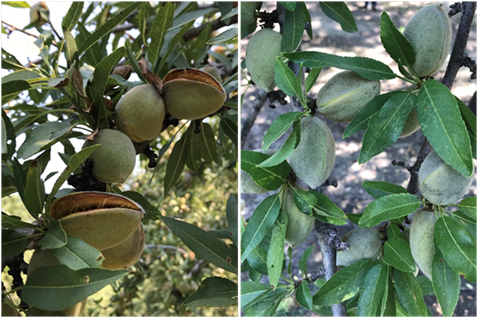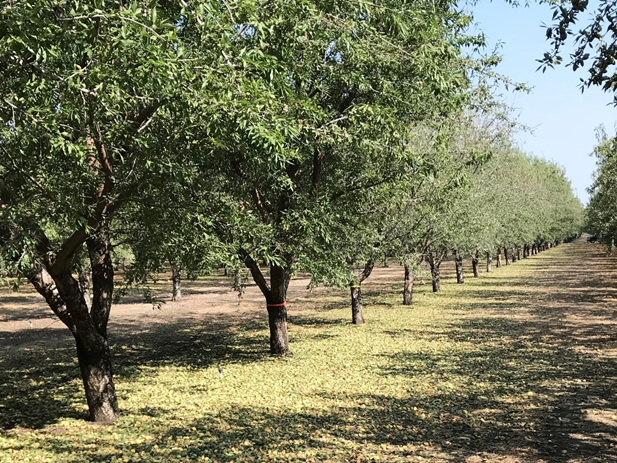Luke Milliron, UCCE Farm Advisor Butte, Glenn, and Tehama Counties
Joseph Connell, UCCE Farm Advisor Emeritus
You’re certainly familiar with the differences in almond hull split and subsequent harvest timing between different varieties. A typical case of this can be observed with early splitting and harvest of Nonpareil relative to other later varieties. However, you may not often think about differences in hull split influenced by rootstock.
The perfect place for observing differences in hull split timing between rootstocks is a rootstock trial overseen by Joseph Connell (UCCE Farm Advisor Emeritus) in Durham, CA. The replicated, and randomized trial currently hosted by Deseret Farms of California was planted in 2010. Six rootstocks are being evaluated: Lovell, Krymsk 86, Atlas, Empyrean 1, Nickels, and Rootpac-R.
The most dwarfing rootstock Rootpac-R had earlier hull split in both 2018 and 2019 than the more vigorous rootstocks. For instance, on July 27, 2018, Nonpareil on Rootpac-R ranged between 60% and 80% hull split, while on the same day, most of the other rootstocks were less than 5% split (photo 1 & 2). On July 30, 2019, Nonpareil on Rootpac-R was at 100% hull split (i.e. ready to shake), while the vigorous Empyrean 1 trees were only 10-20% split.
The approximate order of Nonpareil hull split in the trial influenced by rootstock in both 2018 and 2019 from earliest to latest was Rootpac-R, Lovell, Atlas and Krymsk 86, and finally Nickels and Empyrean 1. While Rootpac-R was ready to shake around July 30, 2019, the much larger Empyrean and Nickels rooted trees weren’t ready to shake until August 16th, over two weeks later.

Photo 1&2. Left photo: Nonpareil on Rootpac-R ranged between 60% and 80% hull split on July 27, 2018; on the same day several other rootstocks were less than 5% split (e.g. right photo: Empryean 1).
Differences in hull split timing and harvest maturity between rootstocks are typically not an important trait because all varieties in an almond orchard are normally planted on the same rootstock. However, if you have multiple orchards, not all planted on the same rootsock, differences in hull split and subsequent harvest maturity between your blocks may be be explained in part by the different rootstocks. Differences in tree size (photo 3), kernel size, yield, nematode tolerance, ability to withstand salinity, wet feet, and many other factors are likely more important when choosing a rootstock. However, if you are planting a new almond orchard, differences in hull split timing and harvest maturity are yet another difference between rootstocks to consider as you decide which rootstock fits best in your farming operation.

Photo 3. The larger Nonpareil on Nickels (foreground, trees ending in orange flagging tape), followed by Nonpareil on Rootpac-R (beginning with yellow flagging tape – 3rd tree from the left).
Curious for more results from UC almond rootstock trials? Attend the 2019 Almond Conference! Or check out the complete 2017/2018 findings.
Curious for more information on what determines hull split timing?
The Almond Doctor Blog on “What influences hull-split timing?”, which focuses on variety and weather effects. You can also try the UC Davis Fruit and Nut Research & Information Center Hull Split Prediction Model, which again accounts for variety and weather effects. Finally, harvest maturity differences between different almond varieties at the previous generation of trial sites, planted in 1993 (see Table 3).
Special thanks to Joseph Connell, UCCE Farm Advisor Emeritus) investigator in Butte County, cooperator Deseret Farms of California, Fowler Nursery, and the Almond Board of California for supporting this rootstock trial of tremendous regional importance!


Leave a Reply